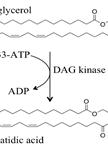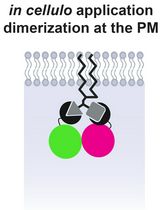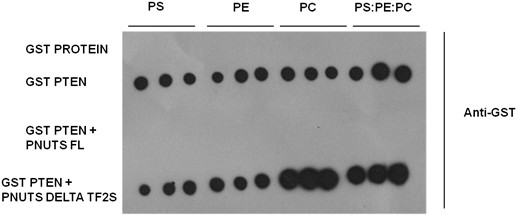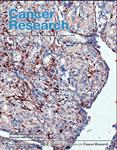- Submit a Protocol
- Receive Our Alerts
- Log in
- /
- Sign up
- My Bio Page
- Edit My Profile
- Change Password
- Log Out
- EN
- EN - English
- CN - 中文
- Protocols
- Articles and Issues
- For Authors
- About
- Become a Reviewer
- EN - English
- CN - 中文
- Home
- Protocols
- Articles and Issues
- For Authors
- About
- Become a Reviewer
PTEN-lipid Binding Assay
Published: Vol 3, Iss 16, Aug 20, 2013 DOI: 10.21769/BioProtoc.869 Views: 11415
Reviewed by: Lin FangFanglian He

Protocol Collections
Comprehensive collections of detailed, peer-reviewed protocols focusing on specific topics
Related protocols

Quantitative Analysis of Cellular Diacylglycerol Content
Fikadu G. Tafesse [...] Hidde L. Ploegh
Aug 5, 2014 12534 Views

Optogenetic Tuning of Protein-protein Binding in Bilayers Using LOVTRAP
Doug Tischer and Orion D. Weiner
Sep 5, 2020 5873 Views

Lipid-Mediated Sequential Recruitment of Proteins Via Dual SLIPT and Dual SLIPTNVOC in Live Cells
Kristina V. Bayer and Richard Wombacher
Nov 5, 2025 1486 Views
Abstract
The lipid and protein interactions are an integral and important part of many cellular signaling pathways. The understanding of the selective and specific interaction of the given lipid molecule with the target protein is required for studying cellular signaling. In this assay, different lipids are spotted onto a nitrocellulose membrane to which they attach. Then the membrane is incubated with a lipid binding protein possessing an epitope tag. The protein binds to the lipid which is detected by immunoblotting with an antibody recognizing the epitope tag (see Figure 1). PTEN is an important tumor suppressor which functions as both protein and lipid phosphatase. The primary physiological substrate of PTEN is signaling lipid PtdIns (3, 4, 5) P3, by dephosphrylating PtdIns (3, 4, 5) P3 to PtdIns (4, 5) P2 PTEN negatively regulates PI3K signaling and mediates its tumor-suppressor function by inactivating downstream oncogenic AKT-mediated signaling. The PTEN lipid binding assay is conducted to study the specific binding of PTEN to different lipid molecules.
Keywords: Kavela

Figure 1. Key steps of the PTEN-lipid binding assay
Materials and Reagents
- Lyophilized lipids:
PE (Sigma-Aldrich, catalog number: P0890 )
PC (Sigma-Aldrich, catalog number: P1652 )
- Hybond C-extra nitrocellulose membrane (Amersham Hybond-ECL, catalog number: RPN303D )
- Bacterially Purified GST-fusion protein (GST-PTEN)
- Anti-GST monoclonal antibody (Santa Cruz, catalog number: SC-138 )
- HRP-conjugated anti mouse secondary antibody (Jackson Immuno Research, catalog number: 315035048 )
- ECL (Thermo Scientific Prod, catalog number: 34080 )
- Methanol
- Chloroform
- 1x TBST buffer (see Recipes)
- Blocking buffer (see Recipes)
Equipment
- Shaker
- Film developer
Procedure
- Reconstitute the lyophilized lipids in a 2:1:0.8 solution of chloroform: methanol: water to make the required stock (all lipids were constituted to make stock of 1 mM).
- Dilute the lipids to get the required working concentration (the working concentration used was 1 nM).
- Spot 1 nM of the lipid dilution onto the Hybond C-extra nitrocellulose membrane (each spot is separated by ~1 cm).
- Allow to dry at room temperature (RT) for 1 h.
- Incubate the membrane with gentle rocking in blocking buffer for 1 h at RT.
- Incubate the membrane overnight at 4 °C with gentle rocking in the fresh blocking buffer containing 20-100 nM of the GST-fusion protein (or other epitope tagged protein).
- Wash the membrane 10 times over 50 min in TBST (use adequate volume of TBST which will cover the membrane ~10 ml).
- Incubate the membrane for 1 h at RT with 1:1,000 dilution of the anti-GST monoclonal antibody in blocking buffer.
- Wash the membrane 10 times over 50 min in TBST.
- Incubate the membrane for 1 h with a 1:10,000 dilution of the HRP-conjugated antimouse secondary antibody in blocking buffer at RT.
- Wash the membrane 12 times over 60 min in TBST.
- Detect the lipid binding protein bound to the membrane by ECL according to manufacturer’s instructions (see Figure 2).

Figure 2. A blot representing the effect of PNUTS on the lipid binding property of PTEN. Nitrocellulose membranes spotted with phophatidylserine (PS) or phosphatidylethanolamine (PE) or phosphatidylcholine (PC) or PS: PE: PC mix (1:1:1) in triplicate was incubated with indicated recombinant proteins. Bound PTEN was detected with anti-GST antibody (adapted from Kavela et al., 2013)
Recipes
- 1x TBST solution (1 L)
50 mM Tris-HCl
150 mM NaCl
0.1% Tween 20
Adjust pH 8 make up to 1 L
- Blocking buffer
3% BSA in 1x TBST
Acknowledgments
This protocol is adapted from Kavela et al. (2013).
References
- Kavela, S., Shinde, S. R., Ratheesh, R., Viswakalyan, K., Bashyam, M. D., Gowrishankar, S., Vamsy, M., Pattnaik, S., Rao, S., Sastry, R. A., Srinivasulu, M., Chen, J. and Maddika, S. (2013). PNUTS functions as a proto-oncogene by sequestering PTEN. Cancer Res 73(1): 205-214.
Article Information
Copyright
© 2013 The Authors; exclusive licensee Bio-protocol LLC.
How to cite
Kavela, S., Shinde, S. R. and Maddika, S. (2013). PTEN-lipid Binding Assay. Bio-protocol 3(16): e869. DOI: 10.21769/BioProtoc.869.
Category
Biochemistry > Lipid > Lipid-protein interaction
Biochemistry > Protein > Interaction > Protein-lipid interaction
Do you have any questions about this protocol?
Post your question to gather feedback from the community. We will also invite the authors of this article to respond.
Share
Bluesky
X
Copy link









